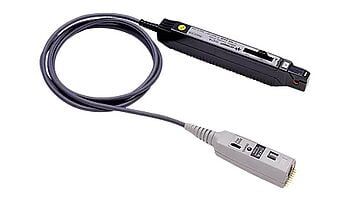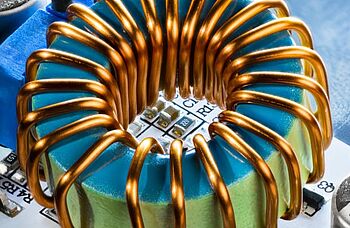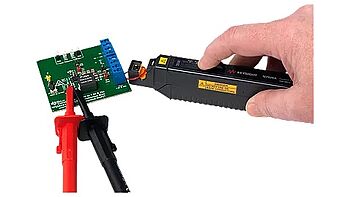This article is brought to you by the Keysight Used Equipment Store. The information applies to used and new equipment.
If you know which Keysight model is of interest to you and matches your technical requirements, visit the Used Equipment Store to see if you can save with our offers.
View Our Offers
For more Test and Measurement knowledge and tips, view all technical articles. Visit our resources
Keysight assumes no liability for the completeness, correctness and accuracy of all content on this website and all of its content. Please read here the terms of use of this website.
Article Feedback
Give us any feedback you might have about this article.
What Is a Current Probe?
A current probe is a device used to measure the amount of current flowing through a circuit. It is placed in series and does not interfere with the operation of the circuit.
A current probe consists of a coil of wire wrapped around a core of magnetically responsive material. The coil connects to an ammeter, which measures the amount of current flowing through the coil.

Current probes are available in various ranges, from a few milliamperes to several hundred amperes. They also have different input impedance values. When choosing a current probe to use with an oscilloscope, it is important to consider the impedance input values, as they can affect the accuracy of measurements.
Buy Oscilloscopes at a Great Discount
- Like-new Condition
- Updated Firmware
- Full Calibration
- New Accessories
- Like-new Warranty
- Customization possible
- Savings of up to 90%
- Working Condition
- Calibrated or Tested
- 30-Day Right-of-Return
- No Customization
- Shipping to limited countries
The Principle Behind Current Probes
Faraday's law of induction is one of the fundamental laws of electromagnetism. In 1831, English scientist Michael Faraday discovered that an electric current produces a magnetic field, and a changing magnetic field produces an electric current. This law is essential in many practical applications, such as the operation of electric motors and generators.
In a current probe, a coil of wire is placed around an electrical conductor, and a magnet creates a moving magnetic field. The coil of wire generates a current, and an ammeter takes the measurement. Current probes help test electronic components and measure the strength of electrical signals.
Current Probe Types
There are two main probe types: active and passive.
- Active current probes contain an amplifier to boost the signal before it reaches the oscilloscope. These probes measure a small current range down to the nanoamp (nA). The amplifier in the probe means that the probe impedance is very low, typically 10 ohms or less. Low probe impedance is essential when measuring high-frequency signals.
- Passive current probes do not contain an amplifier and cannot measure small current readings. These probes connect in series with the measured circuit, meaning the probe impedance is very high, typically 100 k ohms or more. This high impedance makes passive current probes unsuitable for measuring high-frequency signals, but they are more robust and less expensive.
When choosing a current probe, you need to consider the signal type and frequency and the range of currents you need to measure.
- If you are measuring the current consumption of a digital device, you will need to measure tiny current readings down to the nanoamp (nA). In this case, you will need an active current probe.
- If you are measuring the current flowing through an inductor, you will need to measure low-frequency signals. A passive current probe will be suitable for this.
Current probes are available with various input connectors to suit your oscilloscope. The most common connectors are BNC, SMA, and banana.
When taking current measurements, ensure the current probe is connected correctly to provide accurate measurements. The current probe's input connects to the oscilloscope's ground (GND) terminal, while the output connects to the scope’s channel input.
AC/DC Probes
AC/DC probes measure alternating current (AC) or direct current (DC).
- AC (alternating current) is produced by alternating the direction of the flow of electrons in an electrical circuit. AC usually has a sinusoidal waveform.
- DC (direct current) is produced by maintaining the direction of the flow of electrons and the polarity in one direction in an electrical circuit. DC has a rectilinear waveform.
A BNC connector allows the usage of an AC/DC probe with an oscilloscope. The current probe is placed around the conductor, and the BNC lead connects to the oscilloscope. The oscilloscope measures the voltage induced in the conductor by the current flowing through it. The scope then calculates the current using the formula I=V/R, where V is the voltage and R is the resistance.
What Is Current Rating?
The rating of a current probe is the maximum amount of current the probe can accurately measure.
Current probes are available in various ratings, from a few milliamps to several hundred amps. Choosing a probe with a current rating higher than the maximum current flowing through the circuit under test is important, as this allows for safe and accurate measurements.
What Is a Probe Core?
A probe core can be made of different materials. Thecore is the part of the probe that generates the magnetic field of a current probe. Common materials used for probe cores are ferrite and iron.
- Ferrite is a ceramic material used in high-frequency applications. It has a low magnetic permeability, so it does not allow the magnetic field to penetrate easily. This low permeability makes ferrite ideal for current probes because it prevents the magnetic field from saturating the probe’s coil.
- Iron is a metal used in low-frequency applications. It has high magnetic permeability, so it is not as effective as ferrite in preventing magnetic saturation.

What Is Magnetic Saturation?
Magnetic saturation is the point at which a material can no longer become magnetized, and readings become inaccurate. Saturation occurs when the magnetic field lines are so dense that they interact, preventing any further increase in magnetization.
Magnetic saturation can occur in current probes when the current flowing through the circuit is too high. When this happens, the coil of the current probe becomes saturated with magnetic flux, and the probe can no longer accurately measure the current.
What Is a Current Clamp?
A current clamp is an electrical measuring device that measures alternating current (AC) or direct current (DC). Current clamps clamp onto an electrical conductor without making contact with it. This non-intrusive method allows for quick and safe current measurements.

A current clamp has two jaws that open and close around an electrical conductor. The jaws connect to a current transformer, which measures the current flowing through the conductor.
When using a BNC lead, place the current clamp around the conductor and connect the lead to the oscilloscope. The oscilloscope will measure the voltage induced in the conductor by the current flowing through it.
What Are Current Measurements?
Current measurements determine the amount of current flowing through a circuit. Current is measured in amperes (amps).
One amp is equal to the flow of one coulomb per second. A coulomb is equal to 6.24 x 10^18 electrons.
Current measurements are critical in electrical engineering and physics. In electrical engineering, current determines the amount of power flowing through a circuit. In physics, current determines the amount of charge flowing through a conductor.
What Are Current Waveforms?
Current waveforms describe the shape of the current wave as it flows through a circuit. The current waveform is represented on a graph as a function of time. Common current waveforms include sine waves, square waves, and triangular waves.
The resistance of the conductor and the inductance of any coils present in the circuit will affect the waveform shape.
An oscilloscope measures the voltage induced in the conductor by the current flowing through it. The voltage is amplified and displayed on the oscilloscope screen.
What Is a Current Sensor?
Like probes, current sensors are devices that measure the current flowing through a conductor. Current sensors are available in a variety of different types.
| Sensor Type | Measurement Type |
|---|---|
| Clamp-on current sensor | Produces a magnetic field that interacts with the conductor's magnetic field. This interaction produces a voltage proportional to the current. Clamp-on current sensors are useful in circuits where it is not possible or practical to break the circuit to insert a traditional current probe. |
| Inductive current sensor | Uses the inductance of the conductor to measure the current. The sensor can then determine the strength of the original electric current. Inductive current sensors are useful for monitoring electrical equipment for faults and measuring the flow of electricity in power lines. |
| Magnetic field sensor | Like clamp-on sensors, magnetic field sensors measure the current flowing through the conductor by using the magnetic field produced by the current. A common magnetic field sensor is the fluxgate magnetometer which measures the entire three-dimensional magnetic field. |
| Optical current sensor | Uses a light signal to measure the current. Optical current sensors consist of a light-sensitive element, such as a photosensitive diode, and an electronic circuit that converts the light into an electrical signal. The electrical signal can then be amplified and displayed on a meter or other readout device. |
Browse Oscilloscopes at a Great Discount
- Like-new Condition
- Updated Firmware
- Full Calibration
- New Accessories
- Like-new Warranty
- Customization possible
- Savings of up to 90%
- Working Condition
- Calibrated or Tested
- 30-Day Right-of-Return
- No Customization
- Shipping to limited countries
Keysight Oscilloscopes
A digital oscilloscope is an essential piece of equipment when working with electronics, as they allow you to view the shapes of signals and measure voltage. As we have considered, current probes are vital tools used with oscilloscopes to take current measurements. With the right current probe model, you can accurately and non-intrusively measure AC and DC in an electrical circuit. See Keysights Used Equipment to find the right premium used oscilloscope for your needs.

Popular Used Oscilloscopes
Keysight Used Oscilloscopes offers a wide range of industry leading pre-owened oscilloscopes, ranging from older generation Agilent oscilloscopes to the newest Keysight oscilloscope models. So whether you are a fist time buyer, replacing a model like-for-like or looking for upgrade – we have something for you.
This article is brought to you by the Keysight Used Equipment Store. The information applies to used and new equipment.
If you know which Keysight model is of interest to you and matches your technical requirements, visit the Used Equipment Store to see if you can save with our offers.
View Our Offers
For more Test and Measurement knowledge and tips, view all technical articles. Visit our resources
Keysight assumes no liability for the completeness, correctness and accuracy of all content on this website and all of its content. Please read here the terms of use of this website.

































































































